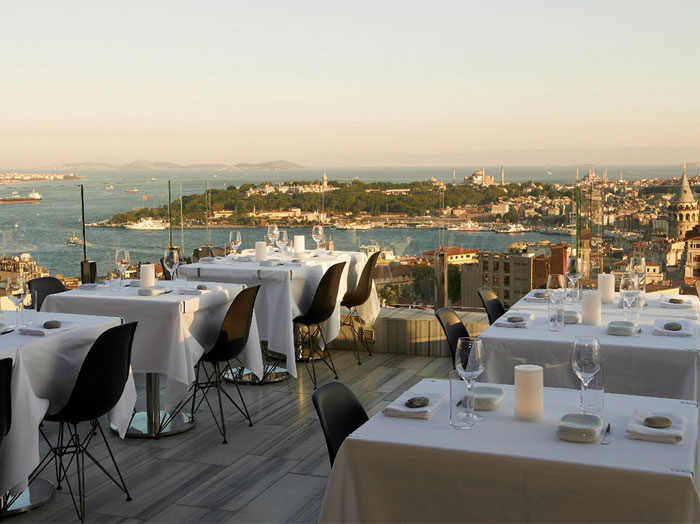The New Anatolian Kitchen
“I believe the time has come to rethink the Anatolian kitchen. A new perspective is needed to allow the rich food cultures from the past to survive and evolve. The New Anatolian Kitchen has no boundaries; it is a way of perceiving food, it is a philosophy that can and should be interpreted in many ways.”
The New Anatolian Kitchen Manifest
- Dare to look at the traditional habits, products and techniques with a new and fresh perspective.
- Make use of the great variety of products that exist in the area, reflect the microclimates and seasons in the cooking.
- Preserve the traditionally “Natural Kitchen” of Anatolia while being forward thinking. Be aware of the deeply rooted cuisine and the multitude of cultural layers.
- Adapt the harmonious past blend of “l’occident & l’orient” to the present.
- Embrace the cultural differences that make the area special and express the “Rich & Vibrant” character of the region in your cooking.
- Truly embrace the saying: “No Farmer, No Food, No Future”. Support the producers that do a good and honest job. Make use of the products that have been produced respecting the land, sea, mountains and animals. Behold the future and use the science. Strive to create traditionally great flavors while considering the contemporary diet.
- Keep void of National, Religious or Ethnic barriers.
The identity of a region, the life and personality of its people is reflected through the food and beverages consumed. By properly identifying a food culture and the kitchen, we may identify the area and its people.
The research and respect of traditions has always been an essential part of the New Anatolian Kitchen. However, each and every one of these traditions should be open for discussion. “Respect the elders and listen to them, yet do not be crushed by them and do not be afraid to turn age old ideas upside down. Mental barriers are very common in rooted cultures, do not be afraid to break them down. To be able to create new ideas and evolve old ones this is necessary. Within this framework, our first step was to search for and try new fields of use for traditional products.
Diversity of ingredients and revitalization of endangered and almost extinct rich resources is an essential part and as important as the methods used. The use of wild plants, flowers and mushrooms was a part of everyday life in the past. How about today? How many species of edible wild plants, flowers, vegetables and animals have survived to this day; in the sea, in the air, on land? How many of them are known and how are they used?
In addition to the concept of taste, the balance of nature and the proper survival of small farmers and the villagers producing natural products are equally indispensable. Without them, there is no kitchen. How many of us big city people are still in touch with the villagers? How many of us can still feel the roots of what we eat? Do we know where our food comes from? Today, more than ever, making an effort to maintain and improve the “neighborhood market” is essential. Demanding GMO free products and soil, supporting incentives for direct sales from producers, are in the hands of us, the consumers. We must not waive the power to demand. “Handsfree food production”, very often considered a sign of development in developing societies, is not an indicator of development. On the contrary, it represents a dangerous world, established on commercial interests, which has become plasticized by the giant wheels of mass consumption.
Today in civilized countries, the tendency to return to the nature and natural products is prominent. Weakening of traditional agriculture will not only cause a socioeconomic disaster, it will also will cause the loss of the age old identities. In our case that would be the loss of identity of the Ancient Anatolian people who have birthed the cradle of the first civilizations on Earth, dating centuries back.
We need to be aware of the diversity, offered by this magnificently potent nature and its cultural riches. Kitchens are doomed to become monotonous when they move away from exploiting diversity. We need to consciously use diverse and ethical products. Only then, so referred “product diversity” may finally leave the books and find life again on our tables.
Anatolia has a unique geographical and cultural position; from the fresh and lively Aegean to the productive and intense Black Sea, to the fierce and exciting South East… It contains very cold and long winters, high mountains, rivers, and is surrounded by seas of different temperatures and salinity. There are many different geographical conditions, spread over a relatively small area. These differences create an immense diversity of products, which is unknown to many. “Geographical Indication” must be introduced in order preserve the uniqueness and proper treatment of these products.
The Anatolian kitchen is not restricted to the Turkish or the Ottoman kitchen. All products of different ethnic origins and religions of Anatolia, the birthplace of cultures during a very long span of time before and after the Ottoman Empire, constitute the kitchen of this region. Wine, born in this region, is an indispensable part of the New Anatolian kitchen.
Along with preserving and resurrecting the past cultures and rich natural resources, looking forward, creating a harmonious new approach between past and future is our true passion. The Ability to look forward and to utilize science, to renew and develop ourselves without forgetting who we are and where we come from, is in fact the great challenge. The New Anatolian Kitchen is not isolated from the outer world! It is open to global developments and it is constantly changing. It is a new concept. Just like wine, it needs time, it must breathe. What we do today, we may have to do differently tomorrow. That’s Ok!

